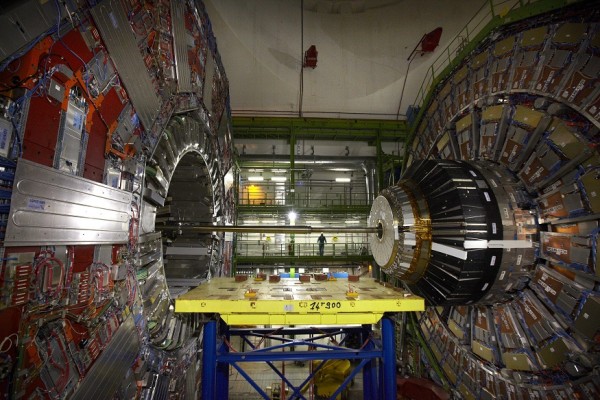LHC Restarts: First Particle Collisions, One Step Closer to Discovering Secrets of the Universe
| Ana Verayo | | May 06, 2015 02:51 AM EDT |
(Photo : Reuters) A technician stands near equipment of the Compact Muon Solenoid (CMS).
The Large Hadron Collider has already began the process of smashing protons together for the first time since it has been shut down in 2013 for energy upgrades in order to push the boundaries of particle physics even further and discover the secrets of the universe.
During the first run of the particle collisions, the collider was set to relatively low energy levels that were part of the preparations for the next stage of experiments at CERN which is the European nuclear research facility near Geneva, Switzerland.
Like Us on Facebook
Colliding protons involve beams being sent in opposite directions around a 17 mile circumference inside the Large Hadron Collider. When these two beams meet in a circle, they will smash together these protons with powerful gigaelectronvolts of energy.
This latest round of experiments will reach higher energies of 6.5 teraelectronvolts per beam that can result in collisions at 13 TeV.
On Tuesday, the first collisions released these subatomic particles into the powerful machine's giant detectors into a cascade. According to Atlas detector official, Dave Charlton, this is an important milestone where there were a lot of smiles in the control room today.
Apart from the Atlas detector, there are three other detectors for the Large Hadron Collider which are CMS, LHCb and Alice, which all recorded breakthrough results from the new tests.
Lower powered collisions can also allow the physicists to tune and calibrate the experiments in order to prepare higher energy runs.
CERN officials state that the LHC team continues to test each component and system including algorithms one by one so that all experiments go through a checklist that can assure their full functionality. This is also to prevent mistakes, bugs or failures during collisions that will be delivered at 13 TeV.
In 2012, the LHC team reached a milestone where they discovered the Higgs boson particle or the "God Particle" that is considered to be the underlying component in the Standard Model of Physics that confers mass in all other fundamental particles.
These new, high powered experiments can also result in evidence of dark matter particles where scientists believe these make up the majority of the mass of the universe.
To date, LHC operations are now halfway thru an eight week period of testing all systems in order to secure all equipment that they can be successful in higher energy collisions that will commence in June.
TagsLHC, Large Hadron Collider, CERN, particle collider, dark mater, LHC restarts first particle collisions
©2015 Chinatopix All rights reserved. Do not reproduce without permission
EDITOR'S PICKS
-

Did the Trump administration just announce plans for a trade war with ‘hostile’ China and Russia?
-

US Senate passes Taiwan travel bill slammed by China
-

As Yan Sihong’s family grieves, here are other Chinese students who went missing abroad. Some have never been found
-

Beijing blasts Western critics who ‘smear China’ with the term sharp power
-

China Envoy Seeks to Defuse Tensions With U.S. as a Trade War Brews
-

Singapore's Deputy PM Provides Bitcoin Vote of Confidence Amid China's Blanket Bans
-

China warns investors over risks in overseas virtual currency trading
-

Chinese government most trustworthy: survey
-

Kashima Antlers On Course For Back-To-Back Titles
MOST POPULAR
LATEST NEWS
Zhou Yongkang: China's Former Security Chief Sentenced to Life in Prison

China's former Chief of the Ministry of Public Security, Zhou Yongkang, has been given a life sentence after he was found guilty of abusing his office, bribery and deliberately ... Full Article
TRENDING STORY

China Pork Prices Expected to Stabilize As The Supplies Recover

Elephone P9000 Smartphone is now on Sale on Amazon India

There's a Big Chance Cliffhangers Won't Still Be Resolved When Grey's Anatomy Season 13 Returns

Supreme Court Ruled on Samsung vs Apple Dispute for Patent Infringement

Microsoft Surface Pro 5 Rumors and Release Date: What is the Latest?










